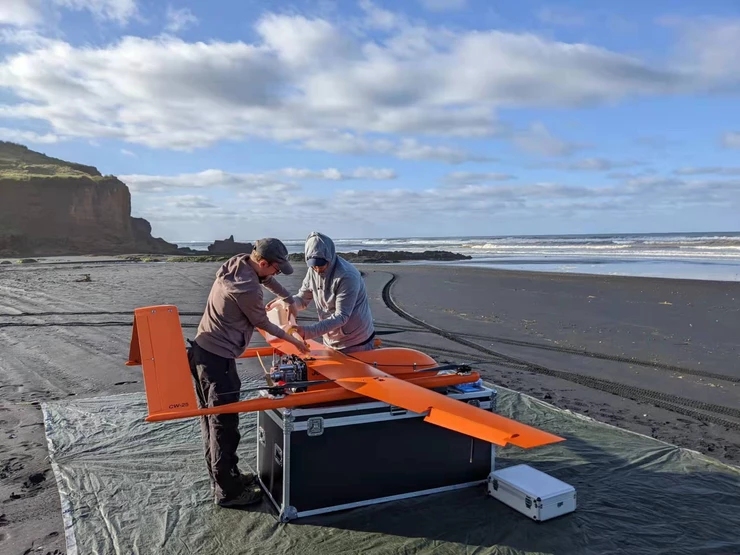MAUI63 Uses AI-powered Drones to Protect Māui and Hector’s Dolphins from Extinction
As the world's smallest and rarest marine dolphin, Māui (Maui) and Hector's dolphins have been classified as Critically Endangered - the most threatened category of species listed by the International Union for Conservation of Nature (IUCN). Recent population estimates indicate that only about 63 individuals over the age of 1 year remain.

Why are the Māui and Hector's dolphins endangered?
Living close to the north coast of New Zealand, Maui dolphins are under constant threat from commercial fishing, including set net and trawl fishing, recreational netting, and diseases including toxoplasmosis and brucellosis. In addition to that, predation, climate change, and toxoplasmosis are also an issue that has contributed to the extinction of Maui's dolphins.
Fishing restrictions are not working
Fishing restrictions have been imposed throughout New Zealand waters to protect these endangered animals. While these restrictions have been helpful in protecting Hector's and Maui's dolphins, accidents still happen. "We need better data and evidence on how these dolphins use and move around their habitat in order to remove all human threats from their habitat as soon as possible", said Jacinda Ardern, the Prime Minister of New Zealand.
The Māui drone project launched
In February 2021, the New Zealand government launched a new project using drones designed to monitor and protect the Maui dolphin. The Maui drone project is a one-year collaboration, involving the Ministry for Primary Industries (MPI), MAUI63, and the World Wildlife Fund (WWF). MAUI63 used a vertical take-off and landing (VTOL) CW-25 drone from JOUAV and outfitted the drone with gimbal cameras and Artificial Intelligence (AI) programs to track Māui dolphins.

Members of the Māui Drone Project with JOUAV CW-25. From left, Willy Wang, Hayley Nessia, Pete Carscellen, and Tane van der Boom. Source from maui63.org.
How do drones revolutionize Māui dolphin conservation?
Previously, Rochelle Constantine, the co-founder of Māui63 would spend about 3 weeks every few years observing Maui dolphins when they were close to shore in the summer. "We would guess where the dolphins would be and hope to spot them from a boat or plane. But this approach was very time and money consuming and the data was inaccurate", said Rochelle, "With JOUAV CW-25 VTOL drone, we can monitor Māui dolphins year round at a fraction of the cost of the previous system".

MAUI163 team is working on CW-25 before the flight. Source from maui63.org
Enable more accurate spatial distribution and habitat models
With the bird's eye view, the drone can find and track Māui dolphins to survey Māui dolphin population abundance and spatial distribution. This can create accurate spatial distribution models and enables fine-scale habitat models.
"Essentially the drone allows us to not just find them and map them but follow them. So, we can really start to understand and know their behaviors in the ocean. CW-25 files between 140 and 160 km/h. It'll fly for six hours on its own. On top of that, a camera – we've got 50x zoom on board, we've got 50 km range from the base station – so we can see full HD video, and because we can fly for such a long period of time, we can actually track them and follow them. Then we can really understand where they’re going and how they move and who they hang out with." said Tane van der Boon, one of the co-founders of Māui63.


Example of how the drone identifies Māui dolphins. Source from maui63.org.
Manage all human threads to Maui dolphins
CW-25 also enables responsive management of remaining fisheries threats. "This particular project is innovation at its best. Using artificial intelligence and a drone we're able to monitor Māui dolphins all year round. All the data will be input back in to help manage fisheries, pollution, and all the other human threads that impact the Māui dolphins. " said Livia Esterhazy, WWF-New Zealand CEO.

CW-25 spotted a Māui dolphin following a fishing vessel. Source from maui63.org.
Drones in wildlife conservation
Drones have become an effective tool for wildlife conservation, creating a relatively cheap, effective, and invasive way to map hard-to-reach areas. Drone surveillance can be used to monitor, count and analyze wildlife to help shape more effective conservation strategies. Using the accurate and real-time data provided by drones, you can provide targeted and more effective interventions to combat invasive species such as foxes, cane toads, and Burmese pythons. Besides, they can also be used as a tool for anti-poaching operations and habitat mapping.





